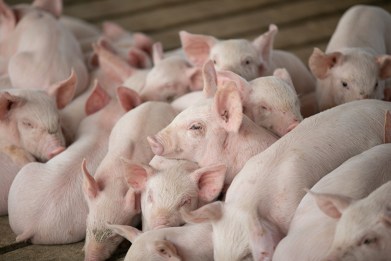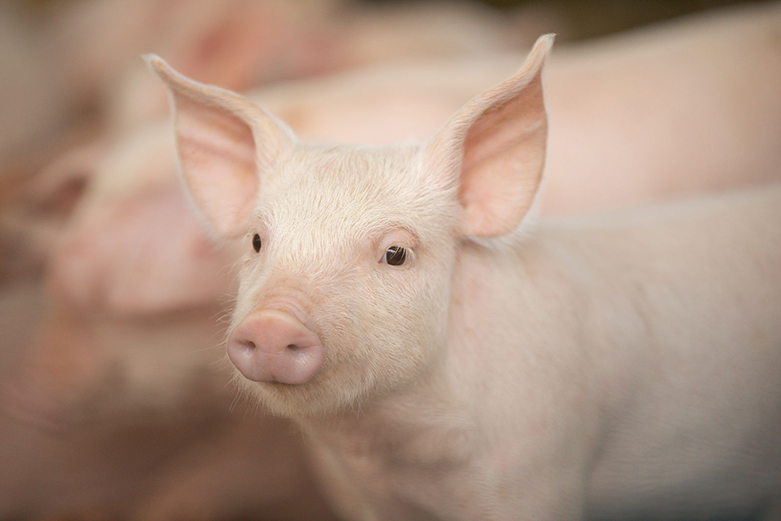Consistently weaning quality pigs is no simple task. Previous articles in this series have provided an overview of producing quality weaned pigs, as well as the importance of health, consistency and thriftiness. No less critical is determining a good combination of age and weight to maximize a weaned pig’s potential. While weaning weight and age may vary from operation to operation, years of research and on-farm evaluations have identified benchmarks that producers can use.

“A number of studies have given us guidance on weight of the pig at birth and at weaning, depending on the number of nursing days,” says Joe Connor, DVM. “A heavier weight pig at birth will result in a heavier weight pig at weaning and a heavier weight pig at slaughter. Most studies indicate that a 1 lb. heavier pig at weaning is a minimum of 2 lbs. at the end of the nursery period and between 4 lbs. and 8 lbs. at the end of the harvest period for the same number of grow days.”
“Piglet weight is marginally inversely related to the number of total-born pigs in the uterus,” Connor says. “Generally, as total born increases, there’s a slight decrease in individual birth weights and more variation of birth weights. We have to accept that having a high total born average is outstanding because it still outweighs any reduction in individual birth weights or increase in variation.”
Genetic Selection
Two critical components to producing a quality weaned pig are the genetic selection of the sow to create a favorable environment for her litter, and mothering ability, says Lindsay Case, Key Account Director in Canada and previous PIC Genetics Services Manager for North America and Latin America.
“When we look at what makes a successful sow, it’s not just total born – it’s also about her ability to give birth to high-quality piglets with heavy birthweights,” Case says (see Chart 1). “In addition, mothering ability includes her ability to successfully wean as many piglets as possible. This is achieved by creating a favorable environment within the farrowing crate and through her ability to milk those piglets really well. 
“From the weight component, it’s about how well the sow can put weight on each of the piglets in the litter to maximize the number of pounds of weaned pig she produces from each turn of the farrowing crate,” Case adds.
“Improvements on litter birthweight and within-litter variation are key for sustainable weaned pig quality,” says Sergio Canavate, PIC technical services director – applied female reproduction. “We are seeing a significant increase in the number of pigs born per litter in the last 5 years, along with improvement on the quality of pigs being born (in terms of weight and vitality). If we are able to increase piglet weight plus increase the percentage of piglets being born that weigh more than 2 or 3 pounds, that will give us better potential to wean a quality pig.”
Health
There’s a direct correlation between health, weight and age, says Connor. It starts pre-farrowing, with the necessary vaccinations and natural exposure of the sow to stimulate colostrum antibodies that the pig will absorb.
“The primary source of a respiratory infection of the pigs is generally through direct transmission (nose-to-nose or saliva),” he says. “If the piglet is not infected during in utero transmission, then colostrum will do an excellent job of protecting that pig for a period of time, but antibody concentration decreases as the pig ages. The half-life of most antibodies is between 14 and 21 days. As the pig gets older (greater than 21 days) antibodies wane and the piglet will not have the same antibody protection as a 1-day-old pig.
“A critical component of health management is to achieve the wean age that will give the highest weight per day of age for the lactating performance of the sow and allow that pig to suckle long enough that the maternal antibodies have not declined past the threshold of pig-to-pig transmission,” he adds.
Sick pigs don’t nurse well, notes Case, which means they’re not getting up and grabbing a teat.
“They’ll have reduced nutrient intake and they won’t meet the weight goals we’ve established compared to a healthier farrowing-crate environment,” she says. “A sick piglet will struggle to show its full genetic potential for quality weaned pig characteristics. We know there’s a correlation between a pig that fails to get off to a strong start in the grow-finish phase and the same pig that was struggling from a health standpoint at weaning.
“Health is one of the fundamental pillars that has to be maintained in the sow farm,” Case says. “It’s almost a minimum hurdle for the piglet to overcome to be able to express its full genetic potential.
Gilt acclimation is a key factor in producing a quality weaned pig, says Canavate. “Gilts are a naïve population – they’re going to a sow farm that has its own environment. We want gilts to be acclimated before they’re bred because the offspring from gilts are more susceptible to disease.”
“The second key is biosecurity, to protect the farm against any threat that can impact performance,” Canavate adds. “We need to make sure farrowing rooms are disinfected and properly cleaned to minimize scours that would impact the pig quite a bit. All procedures for room preparation are also critical.”
The Right Facilities
Facility design and cost are factors, too, Connor adds because as nursing days increase, farrowing crate turns decrease.
“You reach an inflection point where the increased weight of the pig for each nursing day is of less value than turning the farrowing crate,” he says.
The type of facilities on a farm may determine age and weight at weaning, too, says Fernando Gomez, PIC wean-to-finish technical services director. Gomez, a native Chilean, worked in PIC’s Latin market in commercial, technical and export positions.
“It’s a cost-benefit decision,” Gomez says. “Let’s say we’re weaning at 18 days of age – we may not have facilities that are prepared to receive those young pigs, or there may be too much age variation. If we’re working with younger piglets, we might not be receiving the benefits compared to pigs that are 24 days old.”
Also, younger pigs require a higher level of management, he points out. Temperature, nutrition, management, and overall care are higher priorities.
“If we don’t have those parameters in place, it may be better to increase weaning age,” he says.
Article by JoAnn Alumbaugh, and originally featured in Farm Journal’s PORK






